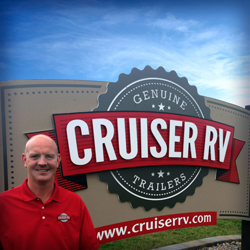Since 1988, the family-owned Cruiser RV, headquartered in Howe, Indiana, has manufactured affordable, lightweight laminated travel trailers for families just getting into camping or seasoned RVers looking for a more robust cross-country adventure.
As a business founded on a family work ethic, one of their guiding principles is that every worker is critical to the overall success of their company and should be treated as such.
“We build each product as if we were making it for ourselves,” goes the company mantra. “We’re not a suit-and-tie type of company. We’re hard-working, extremely efficient, and very lean. We don’t have meetings about having meetings — we get everyone together to talk it out, and then we go execute. We’re focused, and we keep things as simple as we can.”
As a growing company, Cruiser RV had reached a point where they needed to address the working environment of its main production facility in northern Indiana. Making sure the handpicked team of craftsmen and craftswomen were happy and the positive company culture was maintained were extremely important to the Cruiser RV leadership group. The key considerations before making any investment included improving employee comfort on the production floor, reducing ongoing utility expenses long term, and minimizing the number of additional exterior wall and roof cutouts that would compromise the facility itself.
Cruiser RV chose HTHV (high-temperature heating and ventilation) technology to heat their building, and one of the main reasons was the equipment’s ability to destratify the air within their facility without any additional destratification equipment. This kept the initial equipment costs as well as the overall installation costs at a minimum.
The 200,000-square-foot high-bay facility, which operates 24 hours a day and seven days a week, has 28-foot ceilings, an R-19 roof with R-13 walls, and a total of 34 active dock doors.
To prove HTHV’s destratification capabilities at Cruiser’s facility, data loggers were installed to demonstrate minimal temperature differences between the ceiling and the floor. Three data loggers were placed at 2 feet, and three were placed at 5 feet. Temperature readings were recorded every 30 minutes. The design temperature was 63°F at minus 2°F outdoor temperature, and the average building temperature — during the study period of Jan. 1, 2018, to Feb. 19, 2018 — was 64°F, with the coldest recorded outside temperature during the study being minus 15°F on Jan. 1, 2018.
Although the outside temperatures radically spiked throughout this eight-week evaluation period from a record-setting minus 15°F to an unseasonably high 59°F in mid-January, the overall internal temperature did not vary more than five degrees up or down. It remained within a comfortable and constant 65°F to 70°F range. As a result, the production line was much more efficient because the workforce focus was on superior craftsmanship and not the thermostat.
Whether it’s a travel trailer production facility or other high-bay buildings, HTHV heating technology is an energy-efficient solution to heat these types of structures. To learn more about the energy efficiency and destratification of HTHV technology, click here




Report Abusive Comment